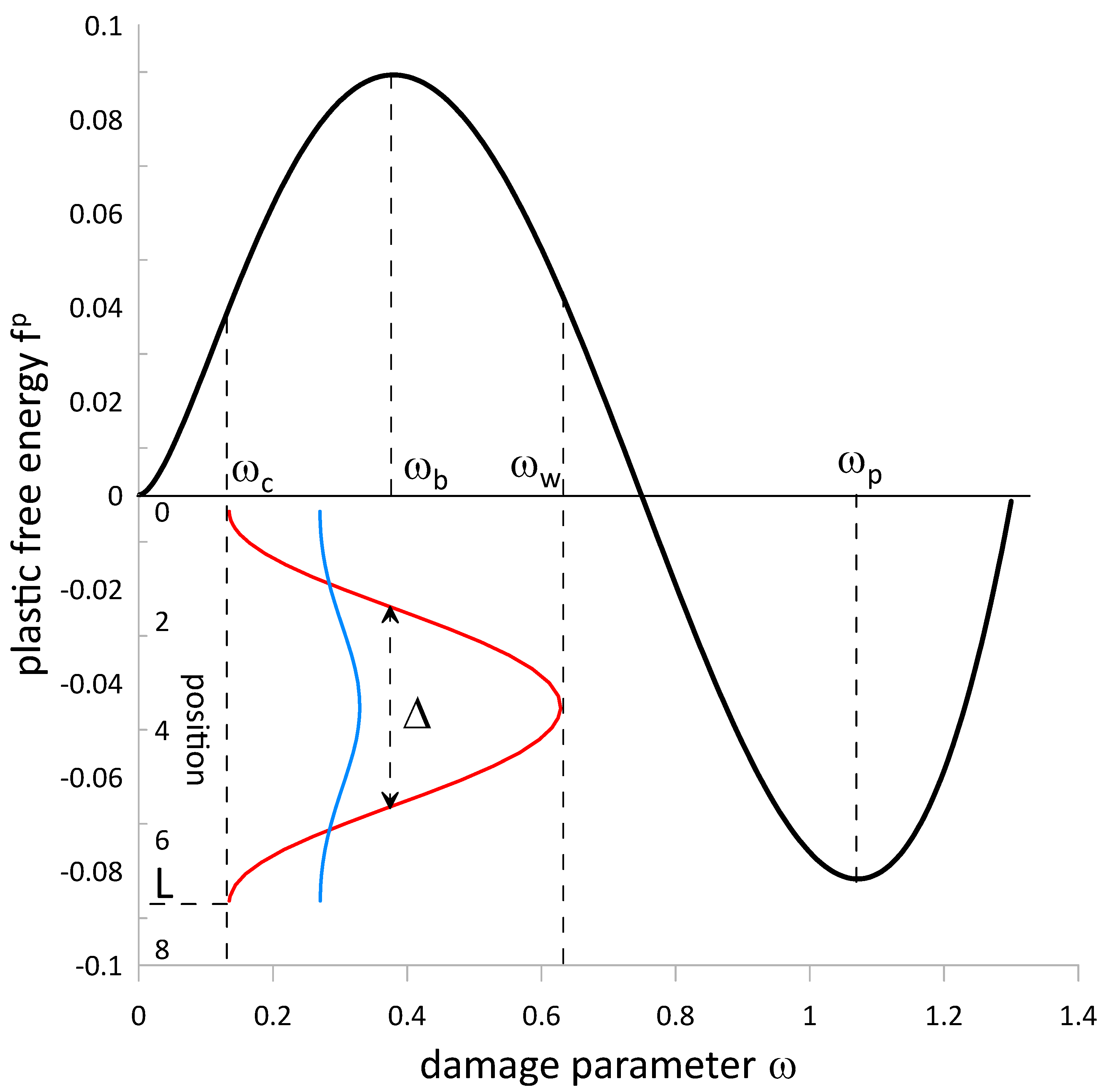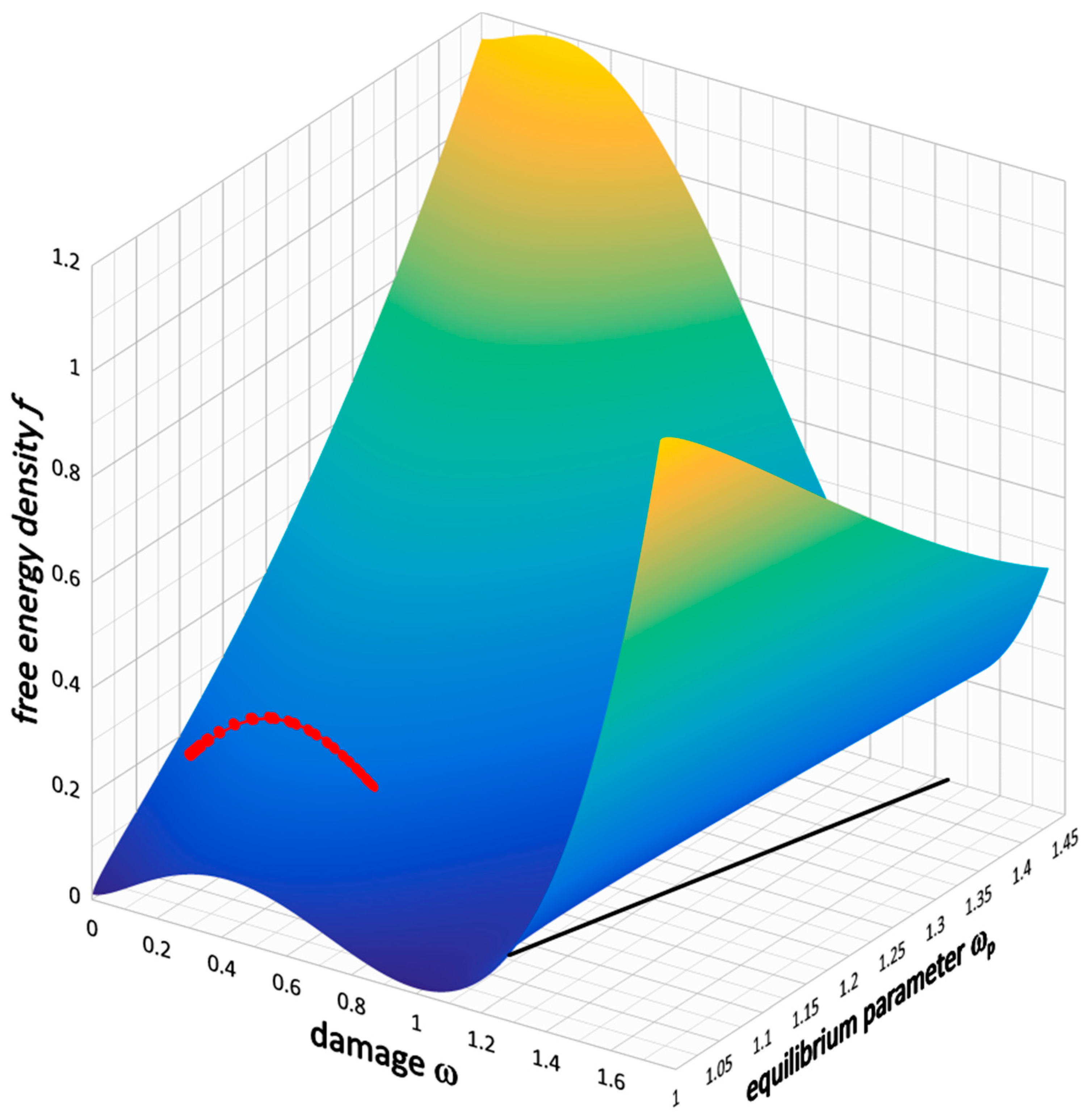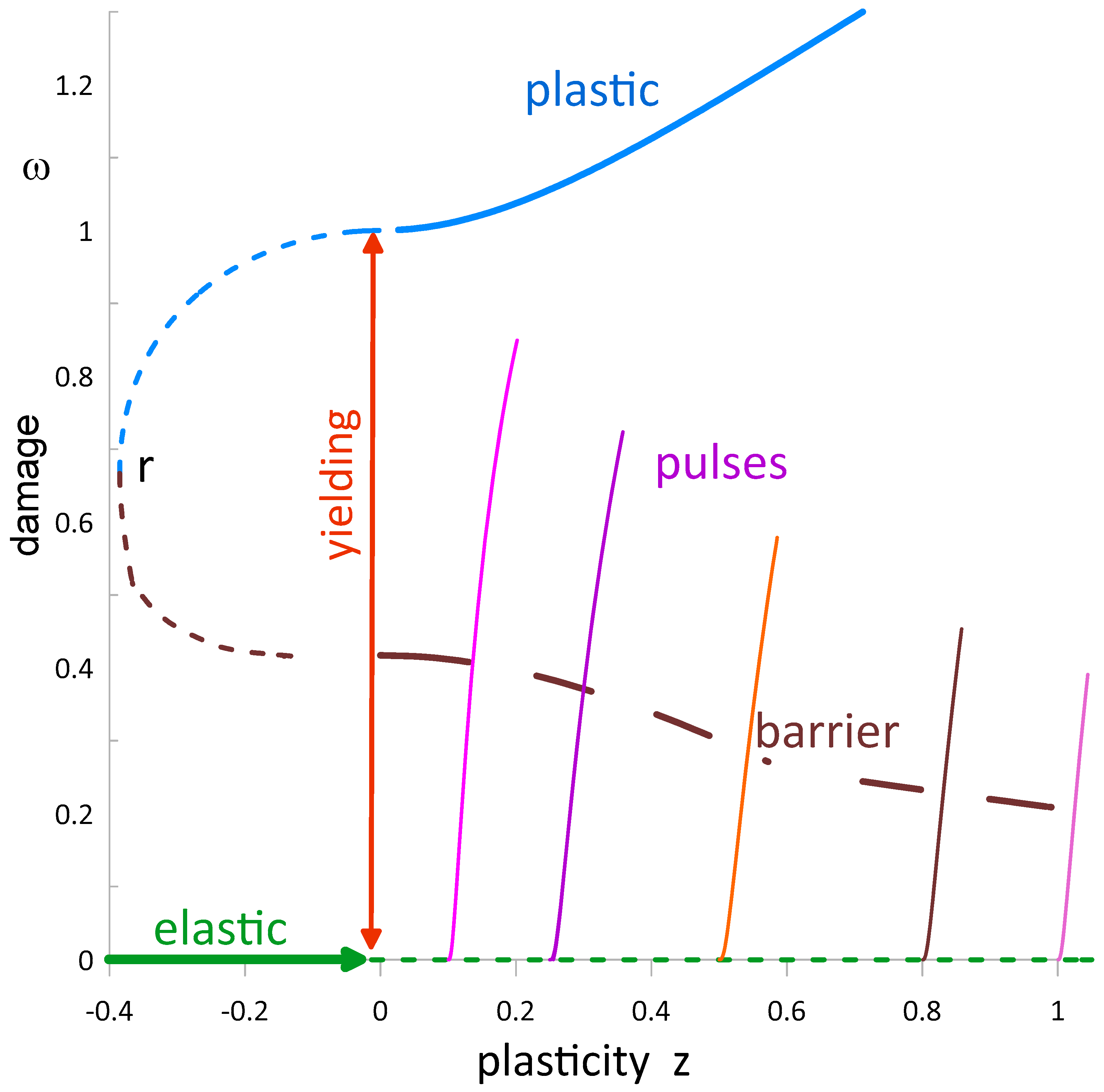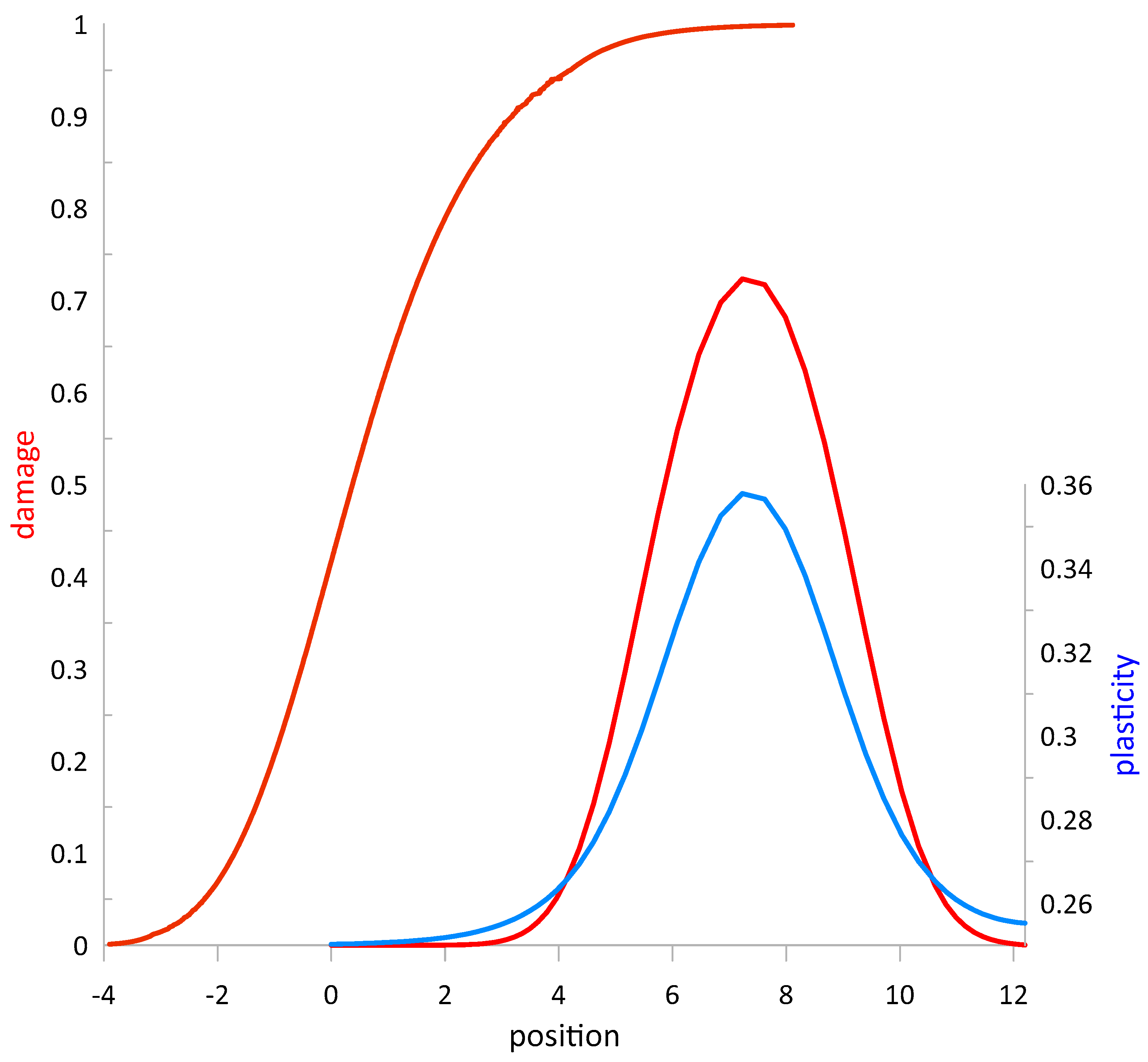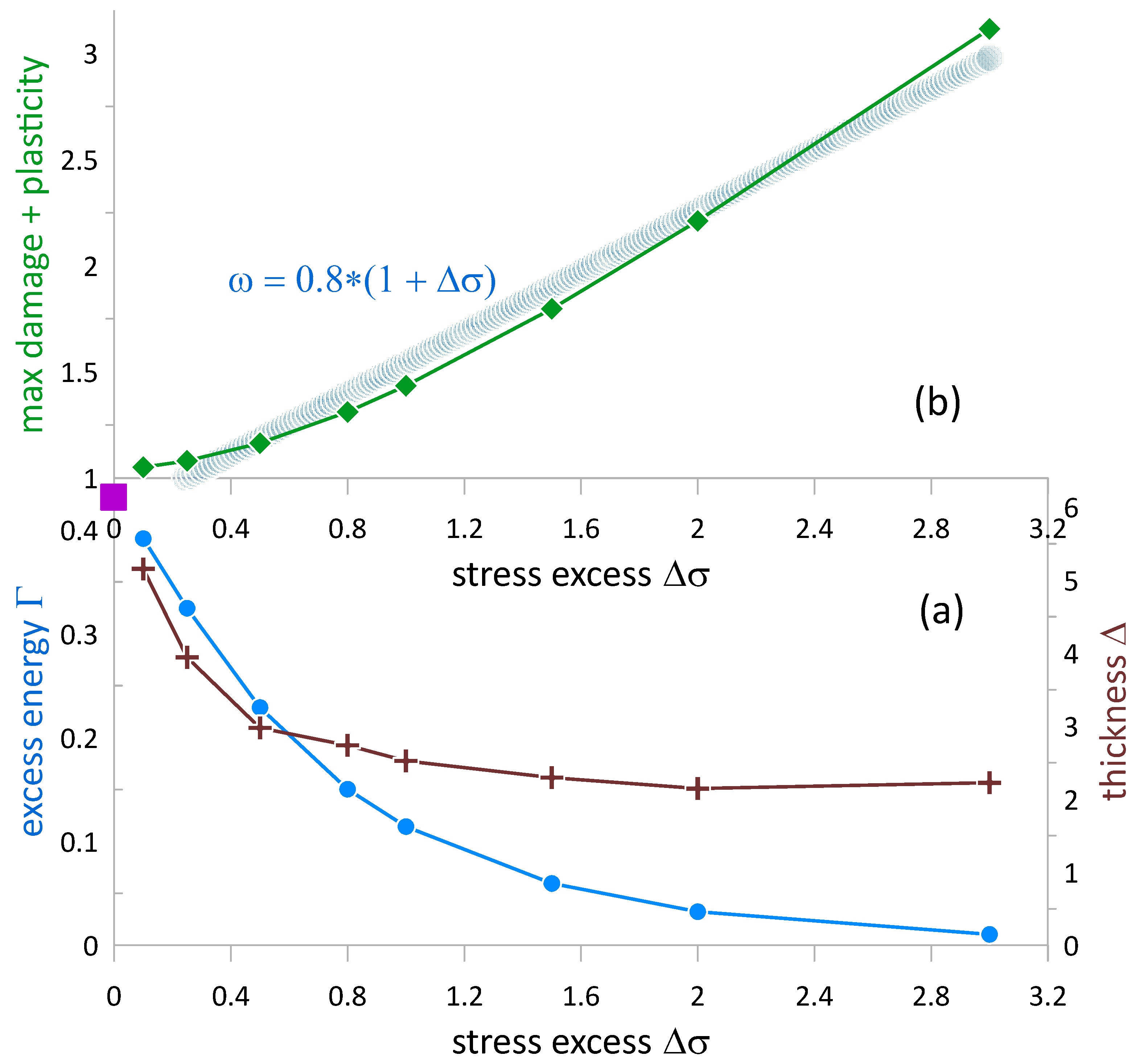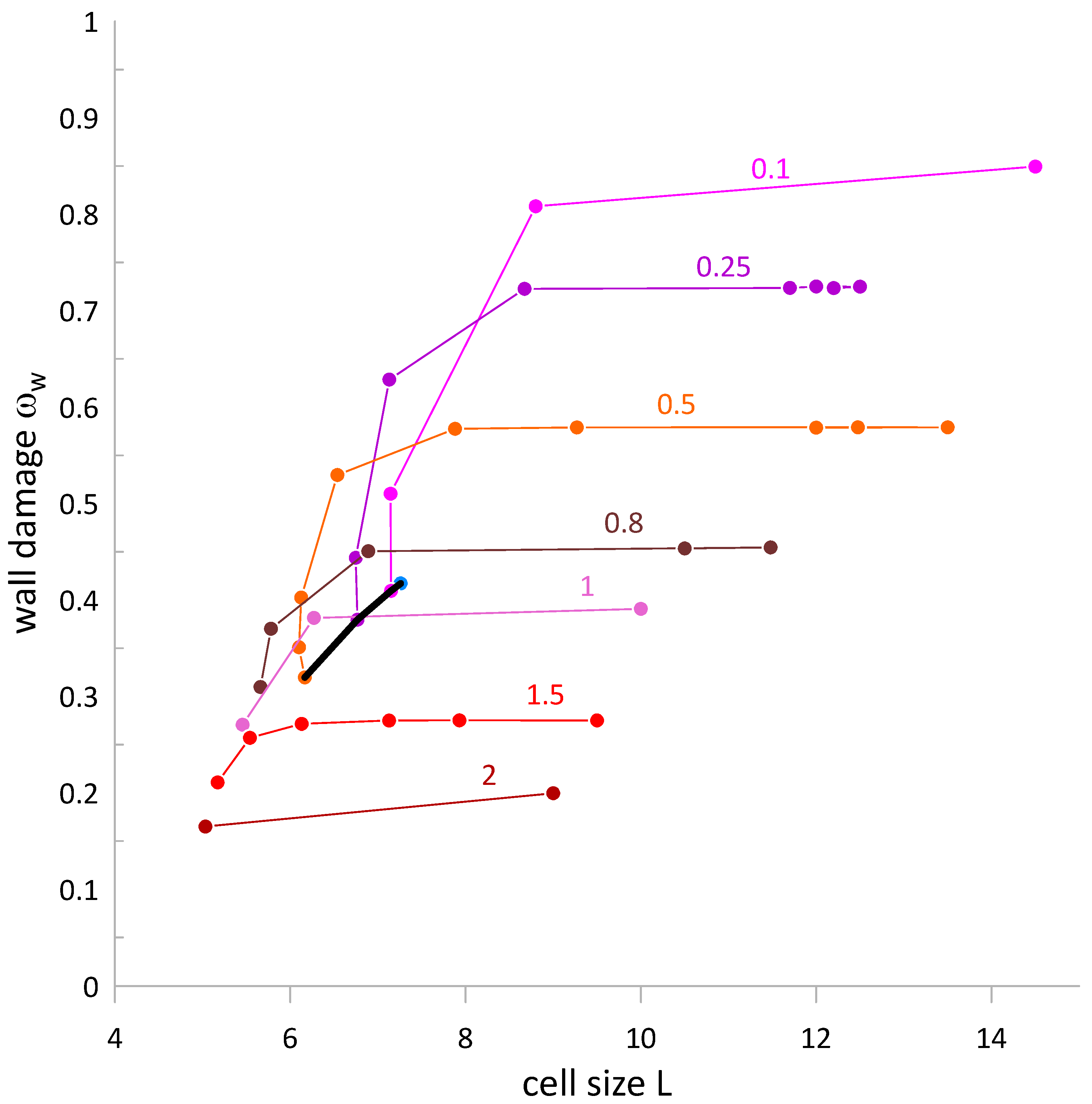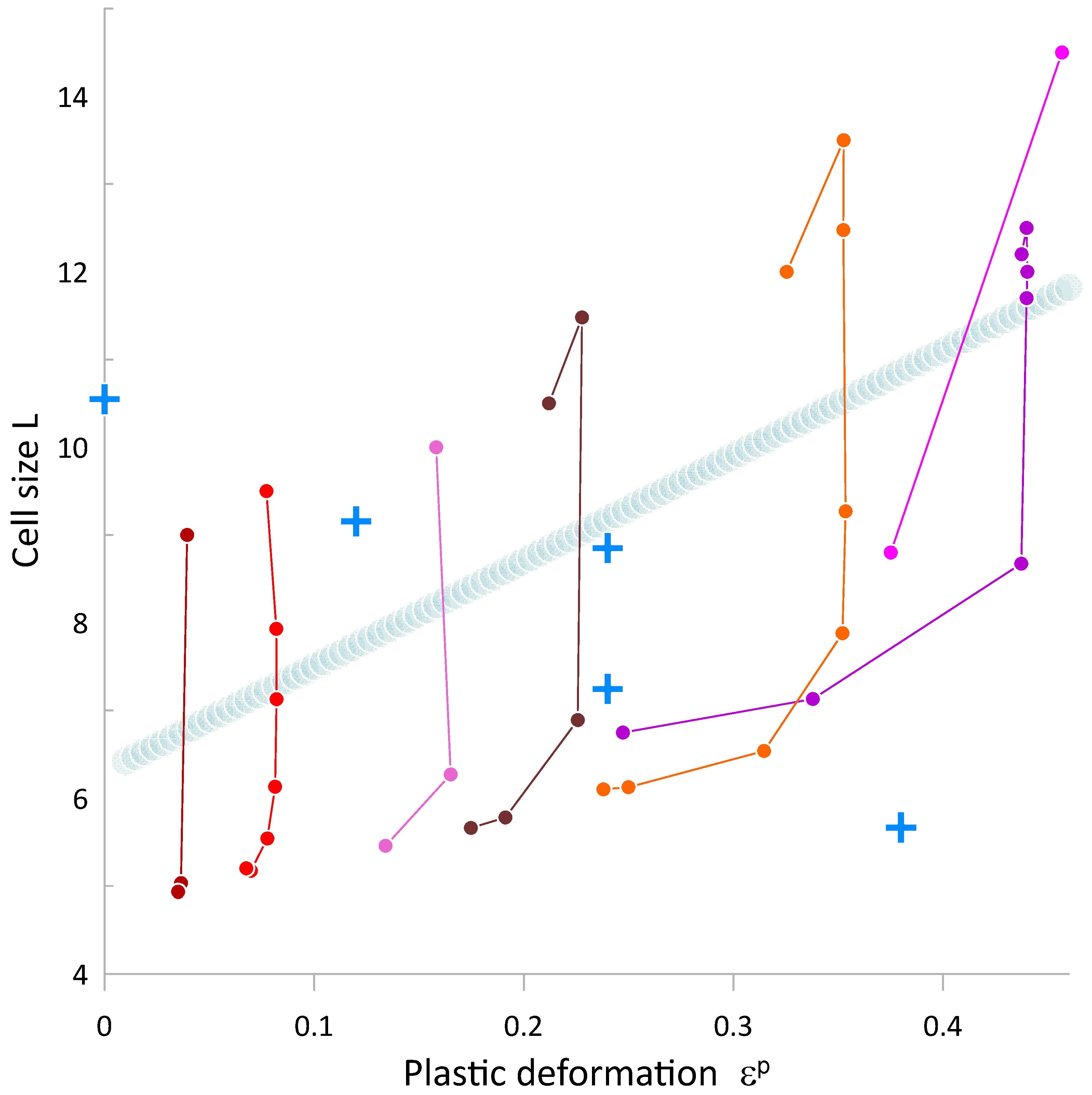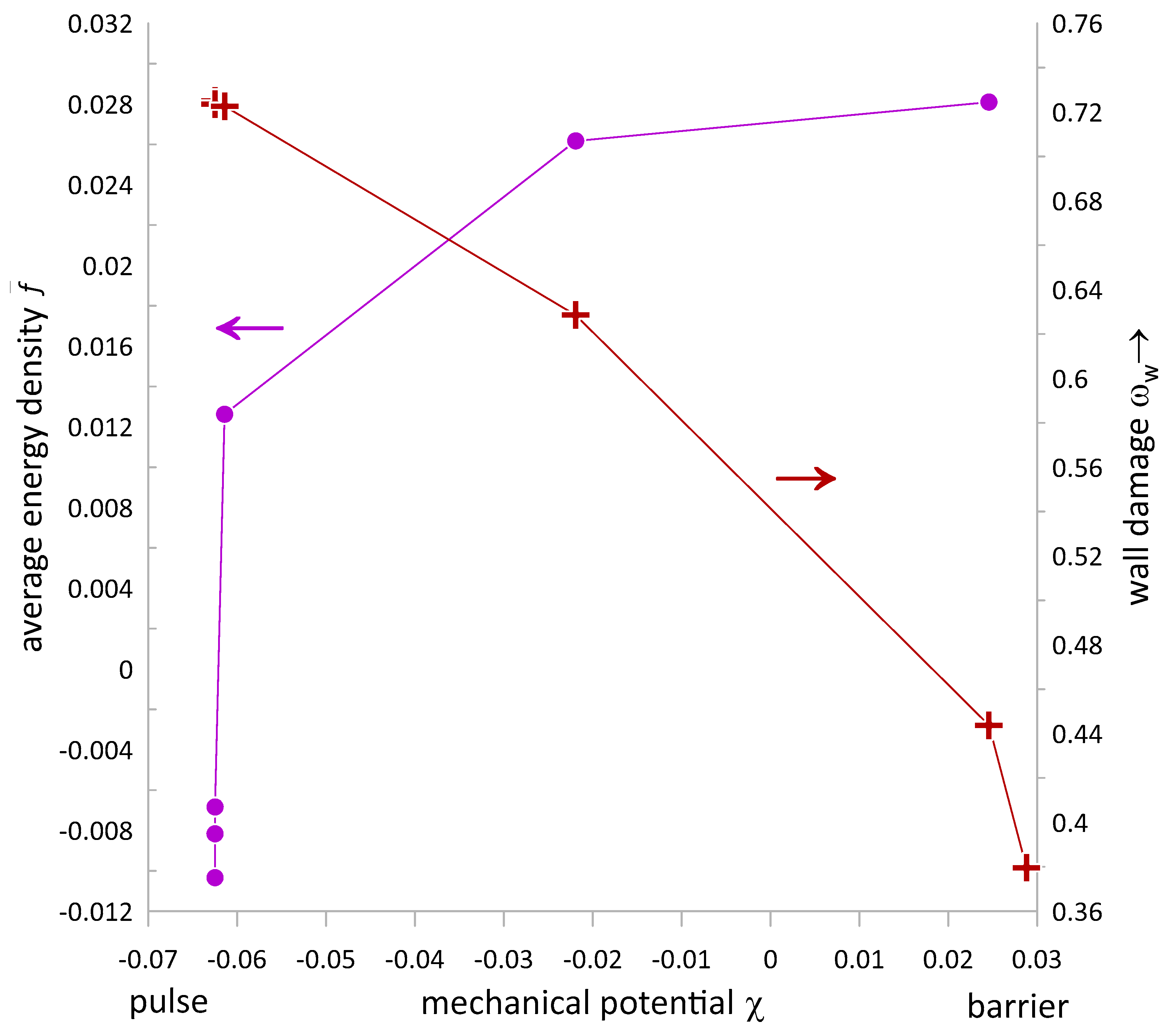1. Dislocation-Mediated Bifurcation Theory of Plasticity
Over the years, a number of dislocation density-based theories of plasticity have been developed. To describe the strain hardening of soft metals, Kocks, Mecking, and Estrin [
1,
2,
3] developed phenomenological models, which made it possible to analyze the plastic behavior of materials both under dynamic loading and creep. The treatment is based on the notion of a kinetic equation relating the equivalent plastic strain rate to the equivalent stress. The model must be supplemented with a structure parameter expressed by the dislocation density that determines the state of the material. To solve the same problem, Langer et al. [
4,
5] considered dislocation lines in the framework of “Cottrell’s birds’ nest” and developed a qualitative thermodynamic theory based on the concept of an effective temperature. For the motion of dislocations, they conceived of a linearized equation, which satisfies the principle of detailed balance. To simulate the development of the dislocation structures in single crystals, Ortiz and Koslowski et al. [
6,
7] developed a phase-field model of dislocations where an integer valued field accounts for the number of dislocations which have crossed over a point. The dislocation density in the model is proportional to the gradient of the field. To describe the evolution of dislocation arrangements the authors invoke a principle of energy minimization at discrete moments when the assumed dissipative nature of short-range interactions between the dislocations gives rise to irreversibility and hysteretic behavior. Although these theories were able to match a few experimental results, their physical bases remain in question.
The density-based theories of dislocation plasticity rely on the knowledge of dislocation energy and internal stress. Gavazza and Barnett [
8] considered the elastic energy stored in the material outside a tube region surrounding the dislocation line. They calculated the self-force on a planar dislocation loop by computing the first variation of the loop self-energy during an arbitrary virtual planar change in the loop configuration. By allowing the dislocation core to spread, Cai et al. [
9] presented non-singular analytic expressions for energy, stress, and forces on the dislocations, which retain most of the analytic structure of the classical expressions for these quantities but without the singularities. Berdichevsky [
10] obtained an expression for the energy of a random set of dislocation lines using its scalar density as the state variable with the intention of using this expression to determine characteristics of dislocation networks.
1.1. Free Energy
It is known that plasticity is an essentially irreversible process, even when it is quasistatic, which puts in question the possibility of developing a thermodynamic theory of plasticity [
11,
12,
13,
14]. One can introduce a
principle of thermodynamic alternative according to which a quasistatic thermodynamic process must be either reversible or hysteretic. Then, plastic deformation becomes an example of a hysteretic thermodynamic process while a phase transition of a reversible one. In [
15], the author developed a thermodynamically consistent theory of plasticity, the most important assumption of which is the existence of the free energy. The theory describes equilibrium states and deformation processes of a specimen by varying the free energy as a function of strain and damage parameter. In [
16], the author extended the concept of damage [
17] to the cases of dislocation-mediated plasticity. A more detailed description of rate-independent plasticity may be developed based on the Preisach model of hysteresis [
18].
The main points of thermodynamic theory of plasticity are as follows: (1) The state of uniaxial tension or compression of a homogeneously (uniformly) deformed virgin specimen may be described by the Helmholtz free energy density f as a function of the total strain ε and damage parameter ω, where f is a sum of the elastic fe and plastic fp contributions. (2) Initiation of plasticity (or termination of elasticity), that is, yielding, is described as a bifurcation in the phase space of the total strain and damage parameter (ε, ω), so that ω = 0 corresponds to the elastic (or quasi-elastic) state of the material and ω > 0—to its equilibrium plastic state with damaged crystalline lattice. (3) The stress/strain reversal (unloading) in the plastic state is described as a turning point where the material returns to the quasi-elastic state with ω = 0 (or nearly zero), and two parameters of the deformation reflecting the history of loading, called back and residual strains (εb, εr), change their values. (4) The failure of the specimen is characterized by the accumulation of a certain value of damage .
After several stages of loading, unloading, and reloading, the state of uniaxial tension or compression of a deformed specimen is described by the Helmholtz free energy density:
The elastic free energy
fe is a function of temperature
T and the difference (
ε −
εr) of the total and residual strains, where the latter is the accumulation of the plastic strains. The plastic free energy
fp is a function of the damage parameter
ω and the
loading function:
which depends on temperature
T, the difference (
ε −
εb) of the total and back strains, where the latter is related to the hardening properties of the material, and yield strain
, which may be zero. The constitutive relation in the theory is as follows:
In the present model, we consider only materials with linear (Hookean) elasticity:
where
μ > 0 is the shear modulus. The strain partitioning into elastic, plastic, and residual parts takes the following form:
where the jump of the residual strain at the turning point
is as follows:
In the theory, we use the hardening rule according to which, after unloading, the representative point of the specimen finds itself on the yield surface. Then,
At the turning point, the free energy experiences a drop in the amount of plastic work:
even if the deformation proceeds quasi-statically. This is a manifestation of the rate independence in plasticity.
The quasistatic processes of loading of a virgin specimen and its subsequent unloading are shown in
Figure 1. Material yielding represents a bifurcation, which is continuous by the free energy but may be continuous or discontinuous by the damage. The unloading, a turning point of loading, is characterized by the discontinuous drops (emission) of damage and free energy. Strain and stress remain continuous in both transitions. In the case of discontinuous-by-damage yielding the damage gap may be overcome by fluctuations.
1.2. Dislocation-Mediated Plasticity
As is known [
8,
9,
10], a 3D network
Γ of mobile dislocation can be described by the density of its lines:
where
is the total length of its lines and V is the volume of the network. The entire body of the dislocation theory motivated the author to introduce a damage parameter in the form:
where
b is the magnitude of the Burgers vector [
16]. Using this definition of the damage parameter, the plastic (microstructure) free energy density can be described by the following expression:
where
is the internal energy density,
is the entropy density, and
is a typical scale of damage in the specimen and
ψ is an entropy factor, which may depend on temperature. The damage parameter in Equations (9) and (10) accounts for the incipient and mobile dislocations and
where
is the average distance between them, while the immobile (forest) dislocations—geometrically necessary and statistically stored—are accounted for, respectively, by the residual
εr, Equations (4) and (5), and back
εb, Equations (2) and (6), strains. In other words, the unloading process immobilizes the mobile dislocations and makes them a part of the elastic continuum. The discontinuous reduction in the damage parameter to zero (or nearly zero) at the turning point describes absorption of the dislocations by the elastic continuum, not the healing of the material. The back strain in Equation (6) is determined by the forest (stored) dislocations and expresses the forest hardening, while the residual strain in Equation (5) is a measure of plastic deformation determined by the geometrically necessary dislocations. Notice that although the total strain is not a state variable, that is, it depends on the deformation path, the differences of the total and residual (
ε −
εr) and the total and back (
ε −
εb) strains are the state variables, that is, they do not depend on the deformation path. In the dislocation theory, the former is the elastic strain, and the latter is polarization. The plastic free energy density, Equation (10a) is plotted in
Figure 2; here and below, all quantities are presented in dimensionless units.
The damage parameter of an equilibrium state is determined by the following equation:
where
For the elastic state
. The damage parameter of the equilibrium plastic state must be found from:
Another solution of this equation is a barrier state with .
The local stability of the equilibrium states is determined by the sign of the second derivative:
The elastic state is always stable because
while for the plastic state we have:
Hence, the plastic state is also locally stable because
while the barrier state is locally unstable because
. At the
critical point of the plastic-state stability:
The global stability analysis of the equilibrium states is based on the calculations of their plastic free energy densities. For the elastic state, it is
, while for the plastic state:
Hence, the plastic state is globally stable for
Not surprisingly, the barrier state is globally unstable because
, which also follows from its local instability. The right-hand sides of the inequalities in Equation (17) are the damage parameter and the loading function of the yield point of the specimen, that is, the point of transition from elastic to the plastic state. The Helmholtz free energy density, Equations (1), (4), and (10), is plotted in
Figure 3 as a function of damage ω and equilibrium plastic damage
ωp, which replaces the loading function φ by Equation (12).
The dislocation-mediated plasticity described by free energy (10) is an example of discontinuous-by-damage yielding, that is, activated plasticity, which has the following distinct features. First, at the yield point, there is a jump in the damage parameter of magnitude
. Second, the elastic-plastic yielding has a small free energy barrier separating the elastic and plastic states:
which can be expressed as a barrier per unit dislocation length:
Third, there is a domain of coexistence of the elastic and plastic states. The domain of stability of the elastic state shrinks with the decrease in the loading function φ.
In Equation (10), the dependence of the plastic free energy on strain and temperature is set by the loading function
which can be derived from a microscopic model of deformation of the dislocation network where the strain is represented by the network’s polarization. If bottom-up derivation is not an option, there is a top-down way to find the function
based on the analysis of the quasistatic unidirectional stress–strain curve of the specimen. First, using the constitutive relation (3), we present the flow stress as follows:
Then, using the equilibrium Equation (12) we obtain:
If stress is set as a function of the strain, variables of this equation separate, and it is readily integrable. If stress is a function of the damage parameter also, Equation (20) can be integrated numerically. In both cases, Equation (12) and the solution of Equation (20) provide a parametric expression for . Notice that if the state of a specimen is set by the applied stress, the barrier and plastic states are strained differently and, hence, the loading function has different values at these states.
Furthermore, using the partitioning of the total strain, Equation (5), one can find an expression for the plastic strain in the form:
Applying Equation (9), we find Equation (21) to be the Orowan expression with the dislocation mean-free path which may depend on strain and temperature.
A popular model of plasticity for many metals and alloys, called
ideal or
perfect, describes a quasistatic, homogeneous, monotonic, and unidirectional deformation by the following stress–strain relation [
19]:
It allows one to resolve Equations (12), (19) and (21) as follows:
where a new quantity, called
plasticity, is introduced:
Notice from Equations (5), (6), and (23) that for the quasistatic ideal deformation
and
. In
Figure 4, the equilibrium state diagram of an ideal plastic specimen with free energy density (10) is expressed in the phase space (
z,
ω).
1.3. Gradient-Flow Dynamic Equation
For the evolution of the damage parameter in a homogeneously deformed specimen in [
16] was derived the gradient-flow equation:
with the relaxation coefficient:
where
D is the dislocation drag coefficient,
n is an integer, and
is an order-of-one positive dimensionless coefficient. (The comment above Equation (26) in [
16] that “dependence of the mobility on volume V constitutes the dynamic size effect” appeared in error).
Equation (24) has a general solution:
where the last expression is for the free energy, Equation (10). The characteristic time of damage evolution is as follows:
where
are average values of damage and loading function.
As the gradient
changes sign at the barrier state, see
Figure 2, the domain of the damage parameter evolution
breaks down into two subdomains:
and
such that the damage is driven to increase in the latter and decrease in the former. For the domain of damage increase, one can define the characteristic time as follows:
where
is the solution of the following equation:
For the domain of damage decrease, the characteristic time is .
3. Scaling Properties of Dislocation Structures
Under practically all conditions of plastic deformation and in a wide range of materials, the microstructures are found to form, which include micron-sized, comparatively free of dislocations cells/subgrains separated by well-defined densely populated dislocation walls/boundaries [
29,
30,
31,
32,
33,
34,
35]. The walls/boundaries may undergo internal, structural changes of their own, transforming from narrow packets of tangles to thin-layered networks. Three spatial characteristics of the dislocation structures, which are most often measured in the experiments, are the dislocation densities in the walls and cells and the cell/subgrain size
L. These parameters change depending on the applied stress or plastic strain. For the size dependence of the dislocation cells on applied stress, almost all studies return a power–law relationship:
where
σint is the internal stress, and the coefficient of proportionality
K is found to be close to 10 and vary non-critically with temperature. The size of the cells was also found to be proportional to the average distance between the dislocations:
where the coefficient of proportionality g is scattered between 10 and 100 [
29,
30,
31,
32,
33,
34,
35]. Combining (37a) and (37b), one obtains that
. Based on these findings, Kuhlmann-Wilsdorf [
31,
34] introduced a “principle of similitude”, according to which cells and walls are
low-energy dislocation structures (LEDS), which shrink in scale as the applied stress is increased. Dislocation structures in stressed metallic materials demonstrate another prominent feature, namely slip lines or bands of localized plastic deformation [
30,
36,
37]. They arise from dislocations gliding on a particular slip plane, in a particular slip direction, under an external load. These structures are critical because the concentrated shear of slip bands can nucleate cracks in the slip plane. The slip lines formed under cyclic conditions are usually called persistent slip bands [
38,
39,
40].
Scaling is an important tool of theoretical analysis as it can help find a particular regime of evolution by hinting at the existence of a particular solution of a problem, its property of self-similarity or “intermediate asymptotes” [
41]. Two major tracks of scaling are dimensional analysis and stretching transformation; their main findings are the π-theorem and renormalization group invariance, respectively [
41,
42]. Expanding the principle of similitude, Zaiser and Sandfeld [
43] conducted scaling analysis of the dislocation structure and found that the static dislocation networks emerging in plastic deformation are often invariant under the stretching transformation:
where
x’s are the Eulerian coordinates of the specimen,
r’s are the dislocation coordinates of the network, and
λ is the stretching factor. Unsurprisingly, the scaling (38) satisfies Equation (37a). Importantly, the properties of the background crystal, which carries the dislocation network, are not subjected to the stretching transformation, Equation (38), that is, the Burgers vectors of the dislocations and the shear modulus of the crystal remain untransformed:
b→
b,
μ→
μ. Then, the dislocation density and network interaction energy transform as follows:
Later, Berdichevsky [
44] expanded the transformation (37)–(39) on the case of varying temperature:
which clarifies the structural relations between characteristic parameters of the networks, the temperature, and internal stress:
As far as the time evolution of the network is concerned, multiple options were found. First, Zaiser and Sandfeld [
43] found that if the dislocation velocity is proportional to the resolved shear stress at the dislocation position, then the stretching transformation must include the following transformation of time:
However, if the dislocation motion is thermally activated, that is, its velocity depends on the interaction energy change, the time remains untransformed:
In addition, Berdichevsky [
44] found that if the dislocation drag coefficient is linearly proportional to temperature, then the time transforms as follows:
Applying the π-theorem, he also found the following dependence of the dislocation internal stress on the control parameters, like strain rate
and temperature
T:
where
F denotes an unspecified functional dependence.
As an extension of the work [
43], the authors identified the limits of the self-similarity imposed by the scaling (38), (39), and (41) on the 3D dislocation networks. Beyond the obvious omissions of the cross-slip and dislocation annihilation, they notice that the internal stress field becomes singular on the dislocation lines themselves, which makes the self-energy logarithmically divergent, violating the scaling (39b).
Let us now analyze the scaling of the theory presented in
Section 1 and
Section 2, taking into account that the properties of the background crystal, like the shear modulus and gradient-energy and dislocation-drag coefficients in Equations (4), (24b) and (28c), do not transform by the stretching, although they may depend on the Burgers vector
b—the microscopic property of the crystal. First, notice that along with the plastic free energy density we consider the elastic free energy density contribution (4), which is a function of the elastic strain, that is, the gradient of displacement u:
. Second, to subject a crystal with a dislocation network to the stretching transformation (38a) is equivalent to subjecting it to another transformation:
that is, to decrease the displacements by λ times. Hence,
The elastic free energy density (4) is essentially a quadratic function of its strain; hence,
Second, using Equations (8), (9), and (39) we obtain the following:
which establishes a structural relation between damage and internal stress:
The plastic free energy density is a sum of the self-energy, energy of interactions, and the entropic contribution. Then, taking into account the logarithmic divergence of self-energy in Equation (10) we obtain:
Finally, taking into account the transformations of temperature (40a) and strain (42b), we obtain from (10b) that
, hence,
and from (10a) that
Furthermore, using (38a), (42b), and (43a) we obtain the stretching transformation for the gradient energy density in the form:
Finally, to calculate the total free energy of a specimen (28a), we add up all components of the density, Equations (44a), (44c), and (45), and integrate them over the volume of the specimen, not the network. Hence,
Moreover, taking into account that in a thermally activated process time remains untransformed, see Equation (41b), we obtain that the gradient-flow dynamic Equation (32a) is invariant with respect to the stretching transformation of (38) if the relaxation coefficient is independent of the damage parameter:
Then, taking into account that
, we obtain that in Equation (32b)
. For a growing network of dislocations, it means that its mean square curvature is preserved [
16]. For the Langevin force, Equation (34c), it means that it is represented by an additive-noise function with the scaling:
. For the properties of the background crystal, it means that
This concludes the renormalization group invariance analysis of the dislocation network evolution, and we can look at its dimensional analysis. The free energy (10) motivates the following scaling of strain, damage, stress, and energy density:
while the dynamic Equation (33) motivates the following scaling of the Eulerian space-time:
5. Concluding Remarks
In this publication, we advanced the thermodynamically consistent theory of dislocation-mediated plasticity, which was started in [
15,
16]. The main assumption of the theory is the existence of free energy. This assumption allowed us, first, to limit the number of independent variables to temperature, total strain, damage, and residual and back strains as the history variables, and second, to expand the free energy in the spatial gradients of strain and damage, Equation (28). The gradient-flow dynamic equation for damage was expanded on the case of inhomogeneous deformation, including processes of dislocation multiplication and annihilation, Equation (33). This equation does not include specific sources of dislocation, and to describe the deformation process, we include dislocation fluctuations in the specimen. In
Section 3, the renormalization group scaling was applied to the equilibrium and dynamic equations of the theory. It shed light on the characteristic features of the network. The low-energy dislocation structures (LEDS) emerge in the theory as ordinary solutions of the equilibrium Equations (51)–(53) without any arbitrary assumptions,
Section 4. They include the state of heterogeneous yielding, slip lines, cell wall structures, and dislocation-free small particles. The emerging theoretical structures can be matched by the dislocation slip-line and cell wall structures observed experimentally,
Section 5. The scaling properties of the theoretical structures, Equations (37) and (43b), and
Figure 6,
Figure 7, and
Figure 9 match the properties of the experimental counterparts. The present theory revealed an important feature of the dislocation structure formation: a possibility of multiple dislocation cell wall equilibrium structures for the same level of applied stress or plastic deformation,
Figure 7a and
Figure 9. That feature had been observed experimentally without clear realization of its physical meaning [
45]. Some of the discrepancies between the theoretical and experimental results may be explained as an artifact of the ideal plasticity of the studied material.
The conducted analysis raised a few questions about the emergent dislocation structures. For instance, why do we observe them in materials although a homogeneously deformed plastic state has less energy as the global optimizer of the system? The answer to this question can be found in Ostwald’s conjecture, according to which the ‘long distance’ between the two homogeneous states is intersected by the intermediate heterogeneous equilibrium states, pulses, and periodic structures, which, although unstable, are ‘closer’ to the initial state. Moreover, the heterogeneous dislocation structures are known to be unstable with respect to small perturbations. Then, how can we observe them in the first place? The answer to this question deals with the defective (e.g., grain) structure of the material.
The conducted theoretical analysis allows us to make several predictions regarding experimental observations of the dislocation structures. First, the theory predicts elevation of strain distribution in the high-density regions of dislocation walls or slip lines, as shown in
Figure 2 and
Figure 5. Such strain elevation may be visualized with the help of one of the atomic-resolution electron microscopy techniques. Second, small particles are known to remain dislocation free under various conditions of loading. The minimal size
of these particles is predicted to decrease slightly with stress, as shown in
Figure 8, and be inversely proportional to the square root of the shear modulus, as described in Equation (61b). In addition, the microstructural analysis of small particles should allow us to evaluate the gradient energy coefficients,
and
, which are critical for the theory. Third, recalling that
and that the edge component of a dislocation network contributes to misorientation between the neighboring subgrains, the theory predicts that misorientation may be estimated as 50% of the total damage in the network.
In the future we plan to include thermal properties and multiaxial deformation into the consideration of non-ideal materials like steel and titanium and aluminum alloys.

